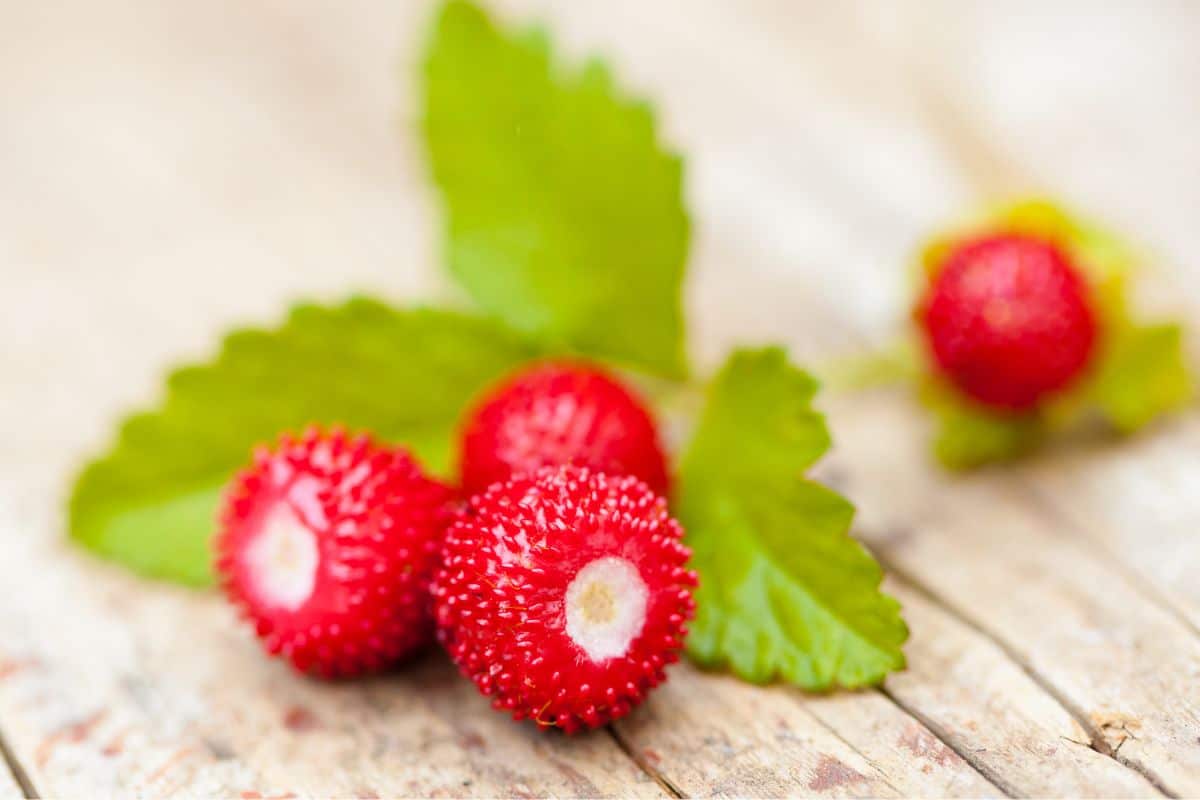From A to Z, there are fruits beginning with each letter (yes, even “Z.”) From apples to mangoes and nectarines to zucchinis, fruits around the world don’t only have unique, delicious flavors, but also fascinating names.

Today, we are skipping the eight letters of the alphabet and focusing on “I.”
We know you’re probably trying to think of fruits beginning with I right now, but you’ll soon find it’s not as easy as it sounds.
Some letters are much easier, such as A and B, but when it comes to I, we may have our work cut out.
In this comprehensive guide, we will explore a variety of fruits with names beginning with “I,” ranging from the well-known to the more obscure.
Discovering these fruits not only expands our knowledge, but also allows us to appreciate the diverse flavors and textures that nature has to offer.
From the health boosting Indian gooseberry to the vibrant and vitamin-rich Indian plum, each fruit brings its unique characteristics to the table.
Whether you’re a fruit connoisseur, a culinary enthusiast, or simply curious about exploring new tastes, this list is a treasure trove of information that will broaden your fruity horizons.
So, join us as we delve into the world of fruits beginning with “I” and uncover the hidden gems waiting to be savored!
1. Indian Plum
First on our illustrious list today is the Indian plum, also known as Osoberry.
This is a fruit that grows on a shrub and belongs to the genus Oemleria. This dark blue fruit is versatile and can be used to create various products such as jams, syrups, and even tea infusions.
Oemleria cerasiformis is the scientific name for this fast-growing shrub, making it the only known species in its genus. This perennial deciduous shrub is fast-growing but is quite short-lived.
The Indian plum is native to lower elevations in southwest British Columbia and grows all the way to the Willamette Valley in Oregon.
You will often find the shrubs growing on the surrounding foothills, but as you go south toward the California Coast Rangers, it becomes less common.
This shrub displays several distinctive features. In late winter, fragrant greenish-white flowers, measuring about 1/2 inch in size, appear in loose hanging clusters consisting of 10 to 20 flowers each.
This early blooming allows the leaves to take advantage of sunlight before the leaves of overstory trees take over and create shade.
The leaves of Indian plum are lance-shaped, alternate in arrangement, and approximately two to five inches long.
They have smooth edges that are slightly rolled under. The leaves exhibit a pale green color, appearing even paler on the lower side, and emit a cucumber-like odor when crushed.
As summer progresses, the leaves start turning yellow.
The twigs of the Indian plum shrub are smooth and purplish brown, featuring noticeable orange pores known as lenticels.
Inside the stem, there are partitions within the pith, creating small chambers that become visible when the twig is split lengthwise.
If you were to eat the bark of Indian plum, you will find that it has a bitter taste.
The fruit of Indian plum measures around 1/2 inch and typically grows in clusters of up to five fruits per flower.
Initially, the fruits are tan to pale orange and gradually transition through shades of pink to reddish purple.
When fully ripe, they acquire a bluish-black color with a thin waxy coat. The fruit contains a stone or pit that houses cyanoglucosides, which are bitter and toxic compounds also found in almonds.
Indian plum is an intriguing shrub characterized by its early flowering, lance-shaped leaves, unique twig features, and distinct fruit development.
However, it’s important to note that the fruit’s seed has some toxicity and bitterness. Therefore, you should be cautious when consuming it.
2. Icaco
The Icaco, otherwise known as a “paradise plum,” is a tropical fruit often found on tropical islands. Growing on bushy trees or low shrubs, this fruit has a mildly sweet flavor that goes wonderfully in jams.
Scientifically known as Chrysobalanus icaco, this fruit is commonly known as cocoplum.
You will find Icaco fruits inland and close to sea beaches in tropical Africa, the Caribbean, tropical Americas, throughout the Bahamas and southern Florida.
In many of these places, the shrub has become invasive and landowners struggle to keep it under control.
The Icaco tree, or shrub, is recognized for having two ecotypes – inland and coastal. The inland ecotype is less tolerant to salt and more upright.
The seed inside the fruit’s hard shell and the ripe fruit itself are both edible with almost no taste. Some describe the taste as mildly sweet, which is why it is often used in jams.
3. Ice Apple
Scientifically known as “Borassus Flabellifer,” the ice apple is a jelly-like fruit, very similar to other fruits, such as Litchis and coconuts.
It is characterized by its hard, tough skin that protects the soft flesh within. The flesh itself is relatively delicate to touch and contains a translucent fluid that seeps out when squeezed or bitten into.
Ice apples are lesser-known tropical fruits that come from the palmyra palm tree. They thrive during the hot, sizzling summer seasons, offering a refreshing and often much needed treat.
Belonging to the family Arecaceae, the ice apple fruit is distinct in its appearance. When fully ripe, it takes on a spherical shape and has a deep brown to black color.
Ice apples are regarded as hydrants because of their high water content. They are also rich in a number of vitamins, including A, B, and C.
The fruit also contains high levels of potassium, iron, zinc, calcium, and phosphorus, to name just a few minerals.
Ice apples are believed to contain numerous biological properties that may be beneficial to humans. They contain various phytonutrients with properties, such as:
- Antioxidants
- Antibacterial
- Anti-inflammatory
- Sedative (can calm and induce sleep)
- Heals wounds
- Laxative
- Can increase hunger
- Diuretic
- Immune response suppressant
- Anthelmintic (could fight off parasitic infections)
It is important to note that ice apples should only be consumed in small quantities, however. There is still not enough research into whether ice apples are safe for pregnant and breastfeeding women, too.
4. Indian Strawberry
Hailing from the Rosaceae family, the Indian strawberry is a variant of a true, standard strawberry. This fruit grows on a flowering plant and is often called a “mock strawberry.”
Scientifically known as Duchesnea indica, this fruit is basically tasteless but has a high protein content. It is also rich in vitamin C and contains quite a lot of sugar.
The Indian strawberry plant is ground hugging and weedy. Its flowers are solitary and develop from leaves that arise from the plant’s stems.
At the base of the flower are five leafy bracts, which are larger than its sepals and have a toothed appearance.
This plant thrives in open areas within prairies, woods, and fields.
Interestingly, it can commonly be found in various settings, such as disturbed areas of land, and urban or suburban regions. In fact, it might even be growing in your very own yard!
Native to eastern and southern Asia, this plant’s species name, indica, reflects its origin from India.
Initially introduced to the United States as an ornamental plant, it has now become a pervasive weed, much to the annoyance of many landowners.
In fact, some states even classify it as invasive due to its ability to rapidly spread and dominate local ecosystems.
5. Indian Gooseberry
Also known as “Amla,” the Indian Gooseberry is a native fruit from, you guessed it, India. Its scientific name is Phyllanthus emblica, and it grows on deciduous trees.
In India, this fruit is extremely popular in various dishes. Thanks to the many health benefits that are associated with Indian gooseberries, supplements are also available.
These are typically made from fruit extracts or powdered dried fruit.
Indian gooseberries are known for their Ayurvedic properties. Just some of the fruit’s potential benefits include:
- Anti-aging properties
- Helps ease heartburn
- Kills cancer cells (studies seem to back this up)
- Reduces blood sugar levels
- Boosts heart health
- Protects against liver damage
- Strengthens the immune system
Indian gooseberries are also believed to improve eyesight and burn fat when included in diets.
Overall, it’s a great way to boost health and its bitter, sour and astringent flavor is best suited in dishes, rather than eaten on its own.
In Summary
The letter “I” doesn’t give us many fruits, but there’s no doubt that fruits beginning with the letter I are some of the most interesting and healthy out there.
Some other worthy mentions include the Indian fig fruit, Indian mango, ilama fruit, and ichigos. Can you think of any more? Get in touch and let us know!






